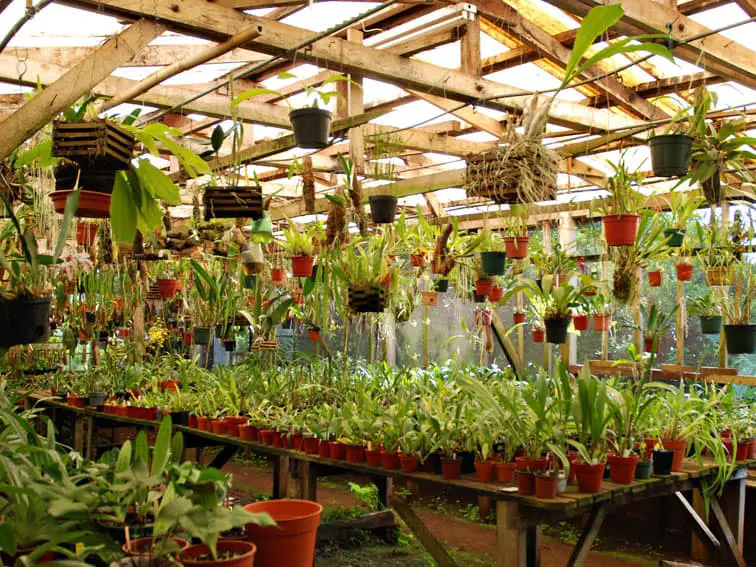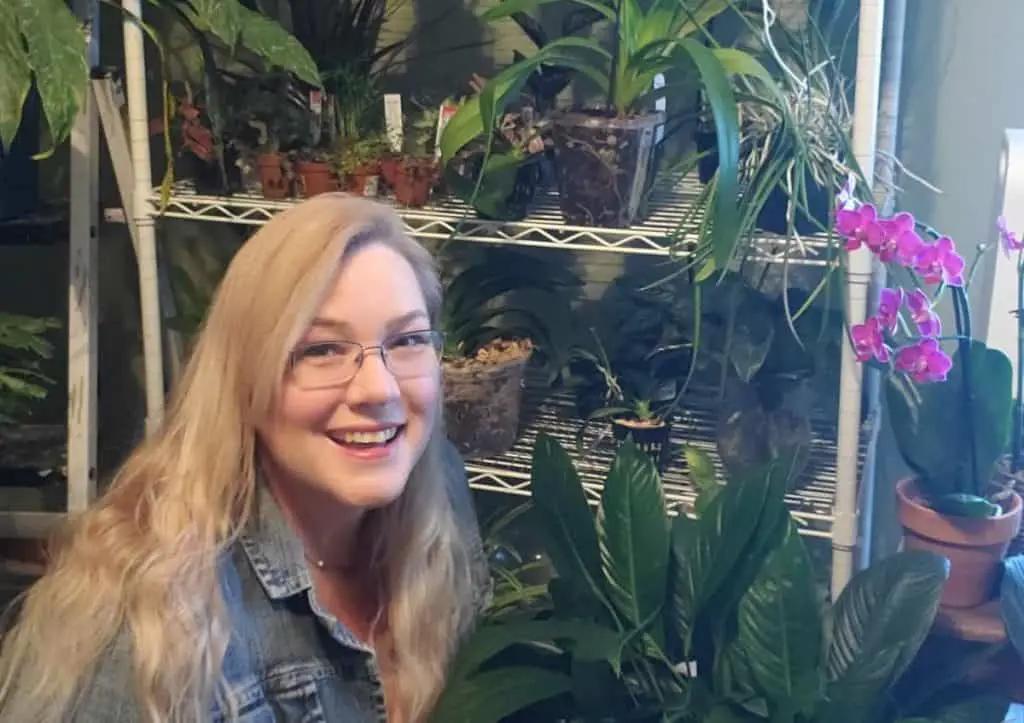There are a few specific articles about greenhouses on the internet, but I didn’t find many that catered specifically about orchids. I’m in the middle of building my greenhouse (I say middle, but I have so much research to do first), and I thought the info that I found may be useful to others who are also wanting to build a greenhouse.
For the location aspect of the orchid greenhouse, I will delve into what to consider during the winter and summer months to ensure optimal conditions for your orchids. This should help you consider a few items when picking that perfect location. I’m dividing these into 2 different categories to make sure they are covered properly. Additionally, I hope to help you with choosing the correct location on your property for your greenhouse. Let’s take a look at winter concerns in the greenhouse first.

How a Greenhouse Aids Your Orchids in Winter
During the winter months, it is crucial to create the optimal conditions for your orchids inside the greenhouse. The key elements to look out for during winter care of orchids are: 1) temperature control, 2) protection from wind and rain, 3) optimal humidity levels, and 4) sufficient light. A greenhouse provides all those element is in the ideal environment for orchids to thrive during the colder months. Let’s look at those one by one.
1. Temperature Control.
One of the key advantages of a greenhouse is its ability to maintain the optimal temperature range for orchids. Orchids are sensitive to temperature fluctuations, and extreme cold can be detrimental to their health. Most orchids prefer temperatures between 60°F to 80°F (15°C to 27°C) but that is a big generalization. Take a look at the article I wrote about temperatures here. However, with proper insulation and heating systems, a greenhouse ensures a stable temperature that protects orchids from harm.
To keep the orchids warmer, a shade cloth just doesn’t cut it (unless you live in very warm climates). Your orchids should be okay outside until the temperatures drop to lower than 60°F (15°C). Then you need to either bring them inside or build a greenhouse.
Heating Up Your Orchid Greenhouse With Heaters
One of the most effective ways to maintain a warm temperature inside the greenhouse is by using heaters. Most articles will say that there are various types of heaters available, such as electric, propane, or gas heaters but…here’s the thing: orchids don’t do well with gas or propane. They are prone to develop bud-blast (read more on bud-blast in this article that I wrote).
that I wrote).
That leaves electric, which is expensive. The other downside to electric is that if you have a power outage (which is very common in my rural area), then the orchids are left to their own luck to survive.
I’ve found that the best type of heating is a radiant-heat flooring (which, I confess, isn’t cheap). This is a type of heater that sits on the exterior of the greenhouse and heats water which runs through pipes on the flooring. Another option is a fan-style heater or placing heat mats under the orchids. I wrote an article about seedling mats that you can read here .
.
By placing the heaters strategically inside the greenhouse or running the hot water pipes under the flooring, you can ensure that the warmth is evenly distributed, creating a comfortable environment for your plants.
Glass and Polycarbonate Sidding
In addition to heaters, the choice of greenhouse materials also plays a significant role in retaining heat. Glass and polycarbonate are excellent options as they have good insulation properties. They can trap the heat inside the greenhouse, preventing it from escaping. This helps to maintain a stable temperature, even during chilly winter nights. Curtains (specifically made for greenhouses) can also be used to further insulate the greenhouse as these are designed to retain heat. I’ve heard of using bubble wrap but I haven’t tried that method yet. By covering the walls and roof with these materials, you can create an additional layer of insulation, reducing heat loss and keeping your orchids cozy.
2. Ventilation During Winter (and Summer too)
Being cooped up during the winter not only gives us cabin fever, but also pneumonia. Plants feel the same to some extent, when there is no air circulation available. Ventilation is not only an important aspect to consider when growing orchids in winter, but a crucial one.
While it may seem counterintuitive to open windows or vents during cold weather, proper ventilation is essential for preventing excessive humidity and condensation buildup. By allowing fresh air to circulate, you can prevent the growth of mold and mildew, which can be detrimental to your orchids. It is recommended to open windows or vents during the warmest part of the day to allow for air exchange without compromising the overall temperature inside the greenhouse.
Not only do you want that warm air to circulate, you need it to be a little moist. The risk of bacteria building up is higher when the humidity is stagnant, and doesn’t flow correctly. Even if you have air vents, adding a fan that can push the humid air around could be necessary (depends on your geographical location).
You can also achieve good ventilation by incorporating vents or louvers into the greenhouse structure. These openings can be manually adjusted to control the airflow and regulate the temperature inside. Additionally, installing an automatic vent opener can be a convenient solution, as it will open and close the vents based on the temperature inside the greenhouse. I won’t be adding this to mine because of my budget, but if you can, then please consider the automatic vents.
How do Greenhouse Vents Work? Greenhouse vents work by allowing hot air to escape and bringing in fresh, cool air from the outside. This process is essential for preventing overheating in summer and renewing the air in winter. It also creates a comfortable environment for your orchids.
There are different types of greenhouse vents available, including roof vents, side vents, and ridge vents. Roof vents are typically located at the top of the greenhouse and are designed to open and close automatically based on temperature and humidity levels. Side vents, on the other hand, are positioned along the sides of the greenhouse and can be manually adjusted to control airflow. Ridge vents are installed along the peak of the greenhouse roof and provide a continuous opening for air circulation.
When the temperature inside the greenhouse rises, the hot air naturally rises to the top. This hot air is then expelled through the vents, creating a vacuum effect that pulls in cooler air from the outside. The influx of fresh air helps to lower the temperature and maintain a more suitable climate for your orchids.
To ensure the vents are functioning optimally, it is important to regularly inspect and clean them. Dust, debris, and obstructions can hinder the proper operation of the vents, so it is essential to keep them clean and free from any blockages. Additionally, it is advisable to check the vents’ mechanisms and ensure they are in good working condition.
Other Items to Consider During Winter in an Orchid Greenhouse
Investing in a thermometer and hygrometer can help you keep track of these factors and make necessary adjustments. Remember that different orchid species have varying temperature requirements, so it is essential to research the specific needs of your orchids and adjust the greenhouse conditions accordingly.
3. Protection From Cold Winter Rain and Violent Winds
Make sure your greenhouse roofing and foundation are structurally sound. Many DIY’s kits do not take into consideration the harsh weather conditions in storms. A greenhouse acts as a shield against harsh winter elements such as wind and rain, so the solid structure of the greenhouse is essential, providing a protective barrier. Yet, you don’t want it to collapse entirely when the weather decides to take it’s revenge.
Greenhouses keep the plants dry during rainy periods, reducing the risk of water-logging and root rot. (Take a look a this article I wrote about Black Rot). Yet since they block out the rain, you need to find another way to keep the ground in orchid greenhouse damp.
Humidity is another crucial factor for orchids. The enclosed space of the greenhouse helps retain moisture, (sometimes too much) creating a humid atmosphere that mimics the orchids’ natural habitat. This is particularly important during winter when the air tends to be drier. The controlled humidity in the greenhouse ensures that orchids receive the moisture they need to thrive and prevents them from drying out. In a large greenhouse, you’ll need a humidifier that will meet your demands. I can’t recommend one as of yet, since I’m still looking for a few.
4. Orchid Greenhouses Need to Provide Optimal Lighting
Furthermore, a greenhouse addresses the challenge of limited sunlight during winter days. While natural sunlight may be scarce during winter, a greenhouse can be equipped with supplemental lighting to provide orchids with the necessary light for photosynthesis and growth. This ensures that orchids receive adequate light even during the darker winter months, allowing them to continue their metabolic processes and maintain their health. If you want more on artificial lighting for orchids, this article about lighting that I wrote may come in handy.
about lighting that I wrote may come in handy.
In conclusion, by utilizing heaters, choosing the right greenhouse materials, and ensuring proper ventilation, you can create a warm and nurturing environment for your orchids. Remember to monitor the temperature and humidity levels regularly to provide the optimal conditions for your plants. With these tips in mind, your orchids will thrive even during the coldest months of the year.
Wow… that was a lot for my first point. But let’s keep going… Lets see how a Greenhouse acts in summer.

How a Greenhouse Aids Your Orchids in Summer
While a greenhouse is commonly associated with providing a controlled environment for orchids during the winter months, it also plays a crucial role in supporting their growth and well-being during the summer. Despite concerns about excessive heat, a properly designed and maintained greenhouse can create the ideal conditions for orchids to thrive even in the hottest months.
Install Fans for Cross-Ventilation
With proper ventilation systems, shading, and insulation, the greenhouse can prevent the summer temperature from rising to harmful levels inside the greenhouse. (I’ve added a complete article especially about humidity which you can read here).
I recommend installing at least four fans strategically placed throughout the greenhouse to ensure proper air circulation, not only for air flow, but to reduce the heat. By positioning the fans at different angles, you can create a cross-ventilation effect, allowing fresh air to flow in and hot air to escape.
Control the Light Exposure with Shade Cloth
In addition to fans and ventilation, shading is another effective method to protect your orchids from excessive heat. Applying shade cloth or using shade paint on the greenhouse windows can help filter out the intense sunlight and reduce the temperature inside.
Shading techniques, such as using shade cloth or applying shading paint to the greenhouse windows, help reduce the intensity of sunlight and prevent overheating. Additionally, insulation materials, such as double-layered glazing or shade netting, can further minimize heat transfer into the greenhouse.
It is important to choose the right shade density based on your geographical climate. In my area, it gets pretty intense with the sun’s rays, so I’m aiming for a 50% or higher shade cloth. This might be too much in your area. A good idea is to ask your local garden shop what % of shade cloth they use for their plants, orchids or not. Some orchid varieties prefer more shade, while others can tolerate higher light levels. Experimenting with different shading options will help you find the perfect balance for your orchids.
Control Watering and Humidity During Hot Summer Months
Watering your orchids properly is crucial during the summer months. I know…. This tip is kind of obvious, but I have heard a few people say that since their orchids were in a greenhouse, they have felt the need to water less. Keep an eye out for your orchid’s watering needs, as they might be a little different than when you kept them inside the house. Here is an article that I wrote about watering cymbidium orchids, but the principles apply to any orchid.
is an article that I wrote about watering cymbidium orchids, but the principles apply to any orchid.
Even in a greenhouse, the heat can cause the potting medium to dry out quickly, so it is essential to monitor the moisture levels regularly. Water your orchids early in the morning or late in the evening to avoid evaporation and ensure that the roots have enough time to absorb the water before the temperature rises. Consider using a moisture meter to accurately determine when your orchids need watering, as over-watering can be just as detrimental as under-watering.
Lastly, providing adequate humidity levels is essential for the well-being of your orchids during the summer. While the outside air may be hot and dry, you can create a more humid environment inside the greenhouse by using a humidifier or misting system. Orchids thrive in high humidity, and maintaining a humidity level between 50% and 70% will help them stay healthy and vibrant.
Having a cool-evaporation fan helps maintain optimal humidity levels if you have long, dry summer months. This prevents your orchid from dehydrating. If your summer months are humid, then you may need to be careful about enclosing the entire greenhouse. Make sure the windows can be opened or vents can be adjusted. The enclosed space of the greenhouse traps moisture, creating a humid micro-climate that mimics the orchids’ natural habitat, but too much can be detrimental.

X marks the spot, but in Which Direction?
Now that you know what to look for during both winter and summer, you can now go about picking that location that serves the above criteria. X marks the spot, but which way after that? Make the long panel north? South? How do I layout the greenhouse on the land? Where should the door go? And the sink?
When it comes to orientating your greenhouse and the structural elements inside it, there are a few key considerations to keep in mind. The placement of doors, majority of plants, sink, and other physical building structures can greatly impact the functionality and efficiency of your greenhouse.
Starting with the east-facing wall, this side receives morning sunlight, which is generally cooler and less intense. This makes it an ideal location for placing doors and windows. By positioning these openings on the east side, you can take advantage of the cooler morning temperatures and allow for proper ventilation. Additionally, placing a sink or water source on the east side can provide easy access for watering your orchids in the morning.
Moving on to the west-facing wall, this side receives afternoon sunlight, which is warmer and more intense. Placing physical building structures like shelves or benches on the west side can help create a buffer between the intense afternoon sun and your orchids. This will provide them with some relief from the heat while still allowing them to receive sufficient sunlight.
For the north-facing wall, it’s important to note that this side receives the least amount of direct sunlight throughout the day. Therefore, it’s best to avoid placing any light-sensitive plants or orchids that require high light levels on this side. Instead, consider using the north-facing wall for storage or as a space for less light-dependent activities, such as potting or maintenance.
Finally, the south-facing wall is the prime location for your majority of plants. This side receives the maximum amount of sunlight during the day, which is essential for the photosynthesis and growth of your orchids. Placing your orchids along the south-facing wall will ensure they receive the necessary light intensity for optimal growth. Implementing shading techniques and proper ventilation will help maintain a suitable environment for your plants.
Don’t Stop Learning!
If you want to be included in more information and get a 14-page fertilization guide, please sign up for my newsletter. I don’t spam, but send emails out bi-monthly with some curious topics of interest. If you want more information, click here to go to a specific page on this website where I explain it more in detail.

Also, if you are looking for an orchid journal to keep your notes specifically about orchid care, check out my 2 solutions for that on this page. If note-keeping isn’t your thing, then there is a free excel spreadsheet that you can download. Click here for more information on how to do that.
If you subscribe to my newsletter, I will send you a 14-page guide on the main tips of orchid fertilizer. It is downloadable and you can print it out on your computer. I designed the guide to double up as a coloring book, just to make it fun.
I hope this article has given some insight to the location of the structural elements and also knowing what to look for both during the winter and the summer months when it comes to designing your greenhouse.
Happy Cultivating!

